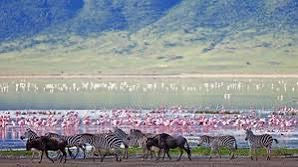
Discover the Ngorongoro Crater: Africa’s Lost World
- claire0052
- Aug 24
- 2 min read
Deep in the heart of northern Tanzania lies one of the most breathtaking natural wonders on Earth — the Ngorongoro Crater. Often referred to as Africa’s Garden of Eden, this massive, unbroken volcanic caldera is a UNESCO World Heritage Site and one of the most iconic safari destinations in the world.
What is the Ngorongoro Crater?
The Ngorongoro Crater is the world’s largest inactive, intact, and unfilled volcanic caldera. Formed around 2 to 3 million years ago when a giant volcano exploded and collapsed on itself, the crater spans about 260 square kilometers and plunges to a depth of over 600 meters (2,000 feet). What remains today is a lush, green paradise teeming with wildlife, encircled by steep crater walls that create a natural enclosure for one of the densest concentrations of animals in Africa.
A Wildlife Haven Like No Other
Within the crater, a diverse range of ecosystems — grasslands, swamps, forests, and lakes — support over 25,000 large animals. This includes:
Lions, leopards, cheetahs, and hyenas
Elephants, often with impressively large tusks due to conservation efforts
Black rhinos, one of the last remaining populations in East Africa
Huge herds of buffalo, zebra, and wildebeest
A stunning array of birds, including flamingos, ostriches, and crowned cranes
Remarkably, most of these animals stay within the crater year-round, creating a safari experience that’s as rewarding in a single day as other parks may offer in a week.

Cultural Heritage and the Maasai
The Ngorongoro Conservation Area isn’t just a wildlife sanctuary — it’s also home to the Maasai people, who have lived in harmony with wildlife here for centuries. Unlike national parks where human habitation is restricted, Ngorongoro represents a unique model of conservation that integrates human presence with environmental stewardship.
Visiting a Maasai boma (homestead) offers an enriching cultural experience, where you can learn about traditional practices, vibrant clothing, and the semi-nomadic lifestyle of one of East Africa’s most iconic communities.

When to Visit
Ngorongoro Crater is a year-round destination, but the dry season (June to October) is typically the best time for wildlife viewing, as animals gather around water sources and the grass is short, improving visibility.
However, the green season (November to May) transforms the landscape into a lush paradise, making it a great time for birdwatching and photography — plus, you’ll avoid peak-season crowds.
Getting There
The crater is a part of the Ngorongoro Conservation Area, which is easily accessible by road from Arusha (around 3.5 to 4 hours). Most visitors combine it with safaris to the Serengeti, Lake Manyara, or Tarangire National Park, making it an essential stop on the famed Northern Safari Circuit.
Final Thoughts
The Ngorongoro Crater is not just a stop on a safari itinerary — it’s a journey into an ancient world where wildlife and landscapes remain virtually untouched by time. Whether you’re a first-time safari-goer or a seasoned adventurer, the crater delivers an unforgettable experience that captures the very essence of Africa’s wild beauty.
_edited.png)


